An Assessment of the Cyto-Genotoxicity Effects of Green-Synthesized Silver Nanoparticles and ATCBRA Insecticide on the Root System of Vicia faba
Abstract
1. Introduction
2. Materials and Methods
2.1. Vicia faba Seed Germination
2.2. Elettaria cardamomum Aqueous Extract Preparation
2.3. Synthesis of AgNPs Utilizing Aqueous Extract of Elettaria cardamomum
2.4. ATCBRA EC Pesticide Concentration Preparation
2.5. Cytological Examination
2.5.1. Mitotic Index (MI)
2.5.2. Chromosomal Aberrations (CA)
2.6. Statistical Analyses
3. Results and Discussion
3.1. Characterization of Elettaria cardamomum Aqueous Extract
3.2. Cardamom–AgNP Characterization
3.3. Evaluation of Cytotoxicity
3.4. Evaluation of Genotoxicity (CA Index)
4. Conclusions
Author Contributions
Funding
Data Availability Statement
Conflicts of Interest
References
- Samfira, I.; Butnariu, M.; Rodino, S.; Butu, M. Structural investigation of mistletoe plants from various hosts exhibiting diverse lignin phenotypes. Dig. J. Nanomater. Biostruct. (DJNB) 2013, 8, 1679–1686. [Google Scholar]
- Butnariu, M. An analysis of Sorghum halepense’s behavior in presence of tropane alkaloids from Datura stramonium extracts. Chem. Cent. J. 2012, 6, 75. [Google Scholar] [CrossRef] [PubMed]
- Smet, H.; Mellaert, H.V.; Rans, M.; Loof, A.D. The effect on mortality and reproduction of beta-asarone vapours on two insect species of stored grain: Ephestia kuehniella (Lepidoptera) and Tribolium confusum Duval (Coleoptera). Meded. Fac. Landbouwwet. Rijksuniv. Gent. 1986, 51, 1197–1203. [Google Scholar]
- Barbat, C.; Rodino, S.; Petrache, P.; Butu, M.; Butnariu, M. Microencapsulation of the allelochemical compounds and study of their release from different products. Dig. J. Nanomater. Biostruct. (DJNB) 2013, 8, 945. [Google Scholar]
- Bostan, C.; Butnariu, M.; Butu, M.; Ortan, A.; Butu, A.; Rodino, S.; Parvu, C. Allelopathic effect of Festuca rubra on perennial grasses. Rom. Biotechnol. Lett. 2013, 18, 8190–8196. [Google Scholar]
- Isman, M.B. Botanical insecticides: For richer, for poorer. Pest Manag. Sci. Former. Pestic. Sci. 2008, 64, 8–11. [Google Scholar] [CrossRef]
- Isman, M.B. Bridging the gap: Moving botanical insecticides from the laboratory to the farm. Ind. Crops Prod. 2017, 110, 10–14. [Google Scholar] [CrossRef]
- Reyad, N.F.; Al-Ghamdi, H.A.; Abdel-Raheem, M.A.; Al-Shaeri, M.A. The effects of botanical oils on the red palm weevil, Rhynchophorus ferrugineus Olivier (Coleoptera: Curculionidae). Appl. Ecol. Environ. Res 2020, 18, 2909–2919. [Google Scholar] [CrossRef]
- El Namaky, A.H.; El Sadawy, H.A.; Al Omari, F.; Bahareth, O.M. Insecticidal activity of Punica granatum L. extract for the control of Rhynchophorus ferrugineus (Olivier) (Coleoptera: Curculionidae) and some of its histological and immunological aspects. J. Biopestic. 2020, 13, 13–20. [Google Scholar]
- Gilani, A.H.; Jabeen, Q.; Khan, A.U.; Shah, A.J. Gut modulatory, blood pressure lowering, diuretic and sedative activities of cardamom. J. Ethnopharmacol. 2008, 115, 463–472. [Google Scholar] [CrossRef] [PubMed]
- Weiss, E.A. Spice Crops; CABI Publishing: Wallingford, UK, 2002. [Google Scholar]
- Zheng, G.Q.; Kenney, P.M.; Lam, L.K.T. Sesquiterpenes from clove (Eugenia caryophyllata) as potential anticarcinogenic agents. J. Nat. Prod. 1992, 55, 1003–1999. [Google Scholar] [CrossRef] [PubMed]
- Chinnamuthu, C.R.; Boopathi, P.M. Nanotechnology and agroecosystem. Madras Agric. J. 2009, 96, 17–31. [Google Scholar]
- Mona, M.A.D. Insecticidal potential of cardamom and clove extracts on adult red palm weevil Rhynchophorus ferrugineus. Saudi J. Biol. Sci. 2020, 27, 195–201. [Google Scholar] [CrossRef]
- Prażak, R.; Święciło, A.; Krzepiłko, A.; Michałek, S.; Arczewska, M. Impact of Ag nanoparticles on seed germination and seedling growth of green beans in normal and chill temperatures. Agriculture 2020, 10, 312. [Google Scholar] [CrossRef]
- Kale, S.K.; Parishwad, G.V.; Patil, A.S.H.A.S. Emerging agriculture applications of silver nanoparticles. ES Food Agrofor. 2021, 3, 17–22. [Google Scholar] [CrossRef]
- Srivastava, N. Assessment of the effects of fungicide (Thiram) on somatic cells of broad bean (Vicia faba L.). Environ. Conserv. J. 2022, 23, 392–394. [Google Scholar] [CrossRef]
- Fernandes, T.C.C.; Mazzeo, D.E.C.; Marin-Morales, M.A. Origin of nuclear and chromosomal alterations derived from the action of an aneugenic agent—Trifluralin herbicide. Ecotoxicol. Environ. Saf. 2009, 72, 1680–1686. [Google Scholar] [CrossRef] [PubMed]
- Mišík, M.; Pichler, C.; Rainer, B.; Filipic, M.; Nersesyan, A.; Knasmueller, S. Acute toxic and genotoxic activities of widely used cytostatic drugs in higher plants: Possible impact on the environment. Environ. Res. 2014, 135, 196–203. [Google Scholar] [CrossRef] [PubMed]
- Rodríguez, Y.A.; Christofoletti, C.A.; Pedro, J.; Bueno, O.C.; Malaspina, O.; Ferreira, R.A.C.; Fontanetti, C.S. Allium cepa and Tradescantia pallida bioassay to evaluate the effects of the insecticide imidacloprid. Chemosphere 2015, 120, 438–442. [Google Scholar] [CrossRef]
- Ma, T.H.; Xu, Z.; Xu, C.; McConnell, H.; Rabago, E.V.; Arreola, G.A.; Zhang, H. The improved Allium/Vicia root tip micronucleus assay for clastogenicity of environmental pollutants. Mutat. Res./Environ. Mutagen. Relat. Subj. 1995, 334, 185–195. [Google Scholar] [CrossRef] [PubMed]
- Kaushik, P.; Goyal, P.; Chauhan, A.; Chauhan, G. In vitro evaluation of antibacterial potential of dry fruit extracts of Elettaria cardamomum Maton (Chhoti Elaichi). Iran. J. Pharm. Res. IJPR 2010, 9, 287. [Google Scholar]
- Soshnikova, V.; Kim, Y.J.; Singh, P.; Huo, Y.; Markus, J.; Ahn, S.; Castro-Aceituno, V.; Kang, J.; Chokkalingam, M.; Mathiyalagan, R.; et al. Cardamom fruits as a green resource for facile synthesis of gold and silver nanoparticles and their biological applications. Artif. Cells Nanomed. Biotechnol. 2018, 46, 108–117. [Google Scholar] [CrossRef] [PubMed]
- Ansari, A.; Khan, M.H.; Yadav, S. GC-MS analysis of bioactive compounds in methanolic extract of seeds of Elletaria cardamomum. J. Surv. Fish. Sci. 2023, 10, 1190–1194. [Google Scholar]
- Alam, A.; Rehman, N.U.; Ansari, M.N.; Palla, A.H. Effects of essential oils of Elettaria cardamomum grown in India and Guatemala on Gram-negative bacteria and gastrointestinal disorders. Molecules 2021, 26, 2546. [Google Scholar] [CrossRef] [PubMed]
- Abdullah Ahmad, N.; Tian, W.; Zengliu, S.; Zou, Y.; Farooq, S.; Huang, Q.; Xiao, J. Recent advances in the extraction, chemical composition, therapeutic potential, and delivery of cardamom phytochemicals. Front. Nutr. 2022, 9, 1024820. [Google Scholar] [CrossRef]
- Abdullah Asghar, A.; Butt, M.S.; Shahid, M.; Huang, Q. Evaluating the antimicrobial potential of green cardamom essential oil focusing on quorum sensing inhibition of Chromobacterium violaceum. J. Food Sci. Technol. 2017, 54, 2306–2315. [Google Scholar] [CrossRef]
- Darsanasiri, A.G.N.D.; Rathnayake, W.G.I.U.; Rajapakse, S.; Rajapakse, R.M.G. In-Situ Deposition of Silver Nanoparticles of Different Colors on Cotton for Imparting Antibacterial and Antifungal Properties. Ceylon J. Sci. (Phys. Sci.) 2013, 17, 31–39. Available online: https://www.researchgate.net/profile/Nalin-Darsanasiri/publication/267388647_In-situ_Deposition_of_Silver_Nanoparticles_of_Different_Colors_on_Cotton_for_Imparting_Antibacterial_and_Antifungal_Properties/links/56664c5708ae15e74634ca81/In-situ-Deposition-of-Silver-Nanoparticles-of-Different-Colors-on-Cotton-for-Imparting-Antibacterial-and-Antifungal-Properties.pdf?__cf_chl_tk=5Tmn.O0B9sJRdVKIHPawGobDAitGrwDIZoz2jev_i38-1735811456-1.0.1.1-z.78WTRO7UtM4WWEE_UnEg1LMirz1DAg2cf9nERtCTg (accessed on 1 January 2025).
- Abd-Elhady, H.M.; Ashor, M.A.; Hazem, A.; Saleh, F.M.; Selim, S.; El Nahhas, N.; Abdel-Hafez, S.H.; Sayed, S.; Hassan, E.A. Biosynthesis and characterization of extracellular silver nanoparticles from Streptomyces aizuneusis: Antimicrobial, anti larval, and anticancer activities. Molecules 2021, 27, 212. [Google Scholar] [CrossRef] [PubMed]
- Zhang, W.; Qiao, X.; Chen, J. Synthesis and characterization of silver nanoparticles in AOT microemulsion system. Chem. Phys. 2006, 330, 495–500. [Google Scholar] [CrossRef]
- Kelly, K.L.; Coronado, E.; Zhao, L.L.; Schatz, G.C. The optical properties of metal nanoparticles: The influence of size, shape, and dielectric environment. J. Phys. Chem. B 2003, 107, 668–677. [Google Scholar] [CrossRef]
- Lee, K.S.; El-Sayed, M.A. Gold and silver nanoparticles in sensing and imaging: Sensitivity of plasmon response to size, shape, and metal composition. J. Phys. Chem. B 2006, 110, 19220–19225. [Google Scholar] [CrossRef] [PubMed]
- Widatalla, H.A.; Yassin, L.F.; Alrasheid, A.A.; Ahmed SA, R.; Widdatallah, M.O.; Eltilib, S.H.; Mohamed, A.A. Green synthesis of silver nanoparticles using green tea leaf extract, characterization and evaluation of antimicrobial activity. Nanoscale Adv. 2022, 4, 911–915. [Google Scholar] [CrossRef]
- Anandalakshmi, K.; Venugobal, J.; Ramasamy VJ, A.N. Characterization of silver nanoparticles by green synthesis method using Pedalium murex leaf extract and their antibacterial activity. Appl. Nanosci. 2016, 6, 399–408. [Google Scholar] [CrossRef]
- Jose, R.A.; Merin, D.D.; Arulananth, T.S.; Shaik, N. Characterization analysis of silver nanoparticles synthesized from Chaetoceros calcitrans. J. Nanomater. 2022, 2022, 4056551. [Google Scholar] [CrossRef]
- Das, J.; Das, M.P.; Velusamy, P. Sesbania grandiflora leaf extract mediated green synthesis of antibacterial silver nanoparticles against selected human pathogens. Spectrochim. Acta Part A Mol. Biomol. Spectrosc. 2013, 104, 265–270. [Google Scholar] [CrossRef] [PubMed]
- Roy, A.; Dharmalingam, K.; Anandalakshmi, R. Silver and zinc oxide nanoparticles in films and coatings. In Biopolymer-Based Food Packaging: Innovations and Technology Applications; Wiley: Hoboken, NJ, USA, 2022; pp. 368–393. [Google Scholar]
- Gajendran, B.; Durai, P.; Varier, K.M.; Liu, W.; Li, Y.; Rajendran, S.; Chinnasamy, A. Green synthesis of silver nanoparticle from Datura inoxia flower extract and its cytotoxic activity. BioNanoScience 2019, 9, 564–572. [Google Scholar] [CrossRef]
- Allafchian, A.R.; Jalali SA, H.; Aghaei, F.; Farhang, H.R. Green synthesis of silver nanoparticles using Glaucium corniculatum (L.) Curtis extract and evaluation of its antibacterial activity. IET Nanobiotechnol. 2018, 12, 574–578. [Google Scholar] [CrossRef] [PubMed]
- Nagaraja, S.K.; Niazi, S.K.; Bepari, A.; Assiri, R.A.; Nayaka, S. Leonotis nepetifolia flower bud extract mediated green synthesis of silver nanoparticles, their characterization, and in vitro evaluation of biological applications. Materials 2022, 15, 8990. [Google Scholar] [CrossRef] [PubMed]
- Malm, A.V.; Corbett JC, W. Improved Dynamic Light Scattering using an adaptive and statistically driven time resolved treatment of correlation data. Sci. Rep. 2019, 9, 13519. [Google Scholar] [CrossRef] [PubMed]
- Maguire, C.M.; Rösslein, M.; Wick, P.; Prina-Mello, A. Characterisation of particles in solution–a perspective on light scattering and comparative technologies. Sci. Technol. Adv. Mater. 2018, 19, 732–745. [Google Scholar] [CrossRef] [PubMed]
- Noga, M.; Milan, J.; Frydrych, A.; Jurowski, K. Toxicological aspects, safety assessment, and green toxicology of silver nanoparticles (AgNPs)—Critical review: State of the art. Int. J. Mol. Sci. 2023, 24, 5133. [Google Scholar] [CrossRef]
- Amooaghaie, R.; Saeri, M.R.; Azizi, M. Synthesis, characterization and biocompatibility of silver nanoparticles synthesized from Nigella sativa leaf extract in comparison with chemical silver nanoparticles. Ecotoxicol. Environ. Saf. 2015, 120, 400–408. [Google Scholar] [CrossRef]
- Das, S.; Mukherjee, A.; Sengupta, G.; Singh, V.K. Overview of nanomaterials synthesis methods, characterization techniques and effect on seed germination. In Nano-Materials as Photocatalysts for Degradation of Environmental Pollutants; Elsevier: Amsterdam, The Netherlands, 2020; pp. 371–401. [Google Scholar]
- Tymoszuk, A. Silver nanoparticles effects on in vitro germination, growth, and biochemical activity of tomato, radish, and kale seedlings. Materials 2021, 14, 5340. [Google Scholar] [CrossRef]
- Taghvaei, M.; Maleki, H.; Najafi, S.; Hassani, H.S.; Danesh, Y.R.; Farda, B.; Pace, L. Using Chromosomal Abnormalities and Germination Traits for the Assessment of Tritipyrum Amphiploid Lines under Seed-Aging and Germination Priming Treatments. Sustainability 2023, 15, 9505. [Google Scholar] [CrossRef]
- Himtaş, D.; Yalçin, E.; Çavuşoğlu, K.; Acar, A. In-vivo and in-silico studies to identify toxicity mechanisms of permethrin with the toxicity-reducing role of ginger. Environ. Sci. Pollut. Res. 2024, 31, 9272–9287. [Google Scholar] [CrossRef] [PubMed]
- Mitra, S.; Saran, R.K.; Srivastava, S.; Rensing, C. Pesticides in the environment: Degradation routes, pesticide transformation products and ecotoxicological considerations. Sci. Total Environ. 2024, 935, 173026. [Google Scholar] [CrossRef] [PubMed]
- Chegini, S.G.; Abbasipour, H. Chemical composition and insecticidal effects of the essential oil of cardamom, Elettaria cardamomum, on the tomato leaf miner, Tuta absoluta. Toxin Rev. 2017, 36, 12–17. [Google Scholar] [CrossRef]
- Ashokkumar, K.; Murugan, M.; Dhanya, M.K.; Warkentin, T.D. Botany, traditional uses, phytochemistry and biological activities of cardamom [Elettaria cardamomum (L.) Maton]–A critical review. J. Ethnopharmacol. 2020, 246, 112244. [Google Scholar] [CrossRef] [PubMed]
- Joseph, R.; Joseph, T.; Joseph, J. Volatile essential oil constituents of Alpinia smithiae (Zingiberaceae). Rev. Biol. Trop. 2001, 49, 509–512. [Google Scholar]
- Gajendiran, A.; Abraham, J. An overview of pyrethroid insecticides. Front. Biol. 2018, 13, 79–90. [Google Scholar] [CrossRef]
- Sadeghnezhad, R.; Enayati, A.; Ebrahimzadeh, M.A.; Azarnoosh, M.; Fazeli-Dinan, M. Toxicity and anti-feeding effects of walnut (Juglans regia L.) extract on Sitophilus Oryzae L. (Coleoptera: Curculionidae). Fresenius Environ. Bull. 2020, 29, 325–331. [Google Scholar]
- Chauhan LK, S.; Chandra, S.; Saxena, P.N.; Gupta, S.K. In vivo cytogenetic effects of a commercially formulated mixture of cypermethrin and quinalphos in mice. Mutat. Res./Genet. Toxicol. Environ. Mutagen. 2005, 587, 120–125. [Google Scholar] [CrossRef] [PubMed]
- Grewal, K.K.; Sandhu, G.S.; Kaur, R.; Brar, R.S.; Sandhu, H.S. Toxic impacts of cypermethrin on behaviour and histology of certain tissues of albino rats. Toxicol. Int. 2010, 17, 94. [Google Scholar] [PubMed]
- Sharma, A.; Yadav, B.; Rohatgi, S.; Yadav, B. Cypermethrin toxicity: A review. J. Forensic. Sci. Crim. Investig. 2018, 9, 555767. [Google Scholar]
- Klášterská, I.; Natarajan, A.T.; Ramel, C. An interpretation of the origin of subchromatid aberrations and chromosome stickiness as a category of chromatid aberrations. Hereditas 1976, 83, 153–162. [Google Scholar] [CrossRef]
- Rao, B.V.; Narasimham, T.L.; Subbarao, M.V. Relative genotoxic effects of cypermethrin, alphamethrin and fenvalerate on the root meristems of Allium cepa. Cytologia 2005, 70, 225–231. [Google Scholar] [CrossRef][Green Version]
- Seven, B.; Yalçin, E.; Acar, A. Investigation of cypermethrin toxicity in Swiss albino mice with physiological, genetic and biochemical approaches. Sci. Rep. 2022, 12, 11439. [Google Scholar] [CrossRef] [PubMed]
- Singh, P.; Tiwari, S.; Agrawal, S.B. Chromosomal and molecular indicators: A new insight in biomonitoring programs. In New Paradigms in Environmental Biomonitoring Using Plants; Elsevier: Amsterdam, The Netherlands, 2022; pp. 317–340. [Google Scholar]
- Asita, A.O.; Makhalemele, R.E. Genotoxicity of Chlorpyrifos, Alpha-thrin, Efekto virikop and Springbok to onion root tip cells. Afr. J. Biotechnol. 2008, 7, 4244–4250. [Google Scholar]
- Sies, H. Oxidative stress: A concept in redox biology and medicine. Redox Biol. 2015, 4, 180–183. [Google Scholar] [CrossRef]
- Gömürgen, A.N. Cytological effect of the potassium metabisulphite and potassium nitrate food preservative on root tips of Allium cepa L. Cytologia 2005, 70, 119–128. [Google Scholar] [CrossRef]
- Guo, W.; Xing, Y.; Luo, X.; Li, F.; Ren, M.; Liang, Y. Reactive oxygen species: A crosslink between plant and human eukaryotic cell systems. Int. J. Mol. Sci. 2023, 24, 13052. [Google Scholar] [CrossRef]
- Srivastava, R.; Kumar, D.; Gupta, S.K. Bioremediation of municipal sludge by vermi technology and toxicity assessment by Allium cepa. Bioresour. Technol. 2005, 96, 1867–1871. [Google Scholar] [CrossRef] [PubMed]
- Kapoor, D.; Singh, S.; Kumar, V.; Romero, R.; Prasad, R.; Singh, J. Antioxidant enzymes regulation in plants in reference to reactive oxygen species (ROS) and reactive nitrogen species (RNS). Plant Gene 2019, 19, 100182. [Google Scholar] [CrossRef]
- Banerjee, B.D.; Seth, V.; Ahmed, R.S. Pesticide-induced oxidative stress perspectives and trends. Rev. Environ. Health 2001, 16, 1–40. [Google Scholar] [CrossRef] [PubMed]
- McCord, J.M. The evolution of free radicals and oxidative stress. Am. J. Med. 2000, 108, 652–659. [Google Scholar] [CrossRef] [PubMed]
- Gill, S.S.; Tuteja, N. Reactive oxygen species and antioxidant machinery in abiotic stress tolerance in crop plants. Plant Physiol. Biochem. 2010, 48, 909–930. [Google Scholar] [CrossRef] [PubMed]
- Babu, K.; Deepa, M.; Shankar, S.G.; Rai, S. Effect of nano-silver on cell division and mitotic chromosomes: A prefatory siren. Internet J. Nanotech. 2008, 2, 2–5. [Google Scholar]
- Sudhakar, R.; Ninge Gowda, K.N.; Venu, G. Mitotic abnormalities induced by silk dyeing industry effluents in the cells of Allium cepa. Cytologia 2001, 66, 235–239. [Google Scholar] [CrossRef]
- Sobieh, S.S.; Kheiralla ZM, H.; Rushdy, A.A.; Yakob NA, N. In vitro and in vivo genotoxicity and molecular response of silver nanoparticles on different biological model systems. Caryologia 2016, 69, 147–161. [Google Scholar] [CrossRef][Green Version]
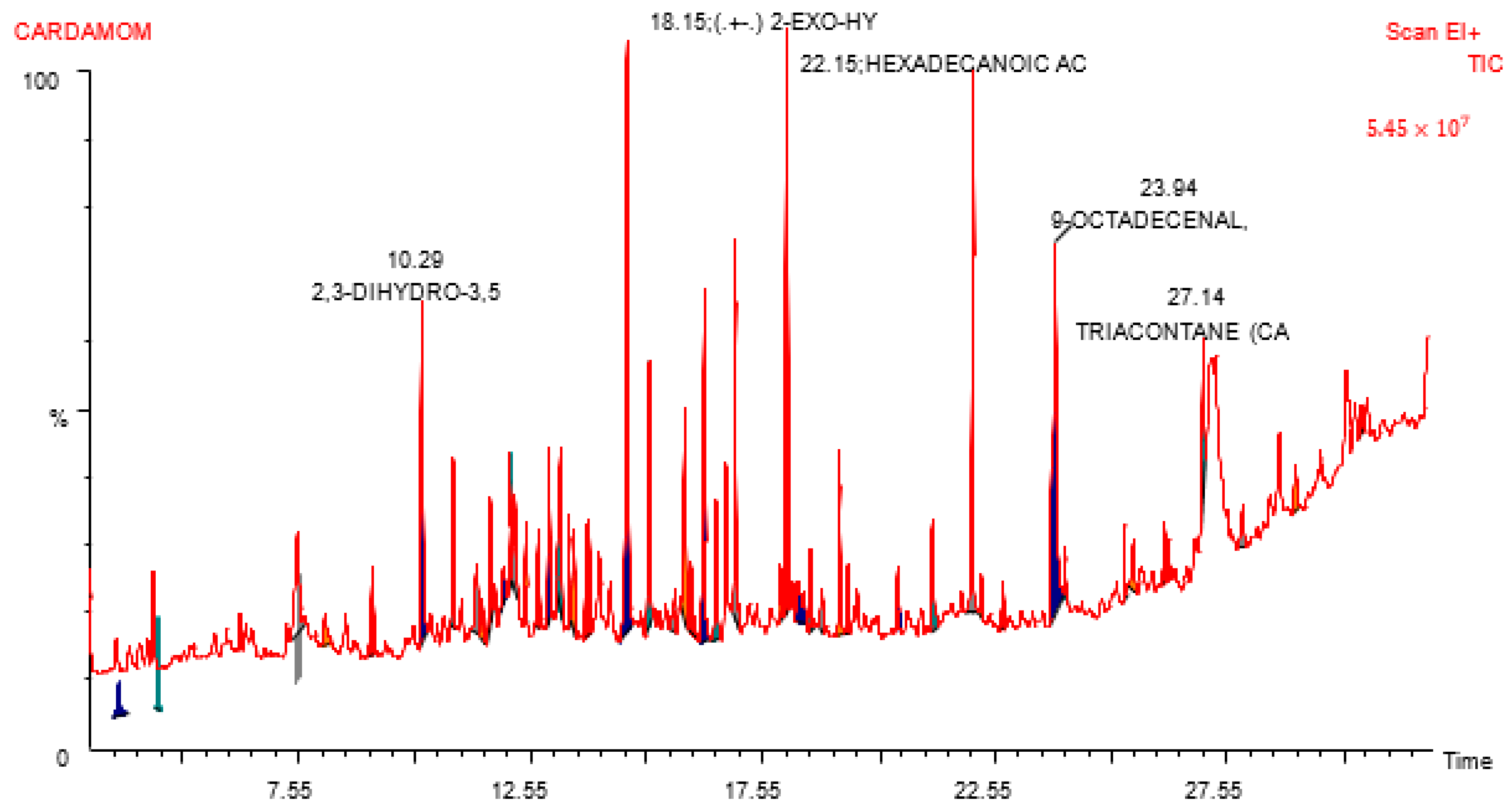
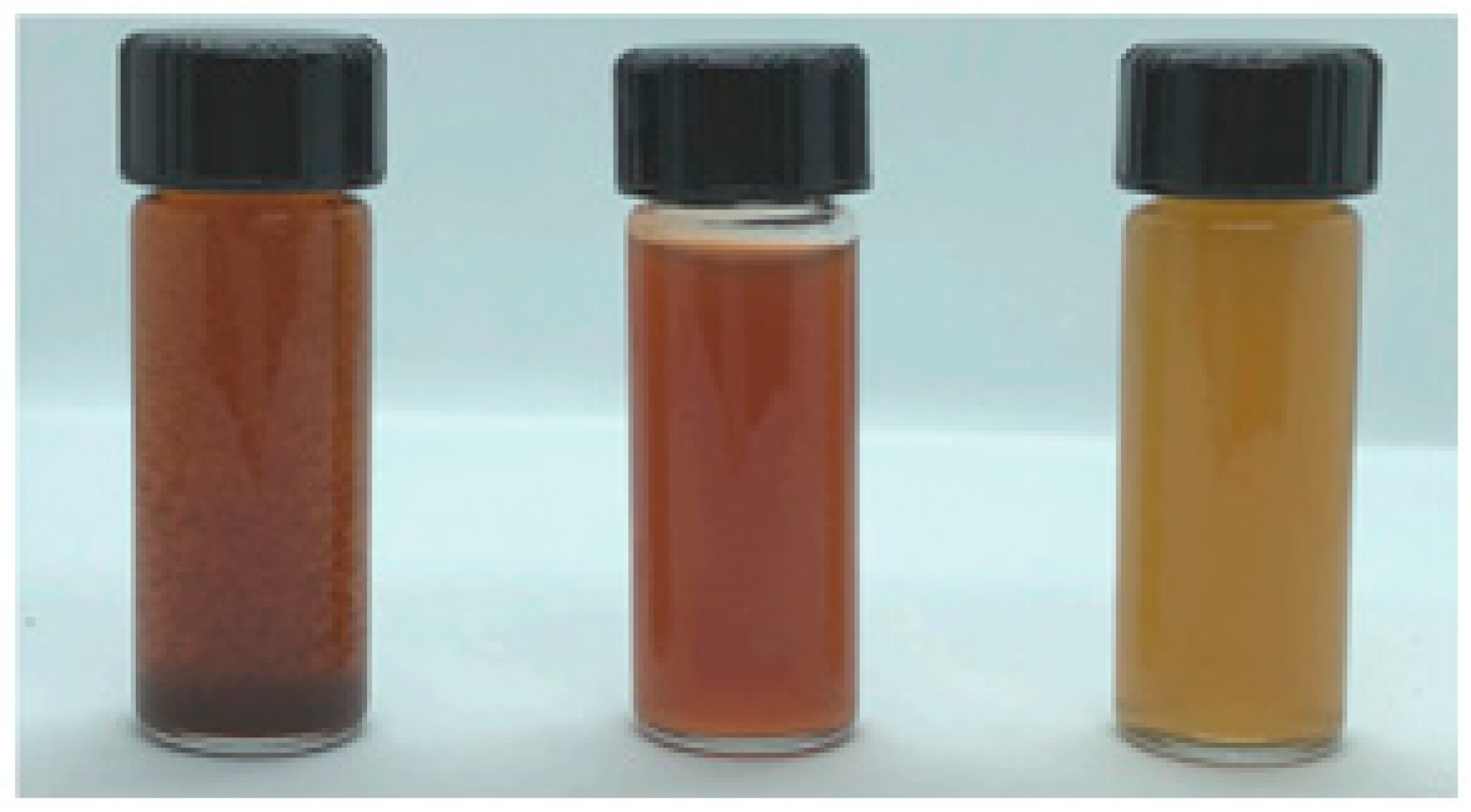
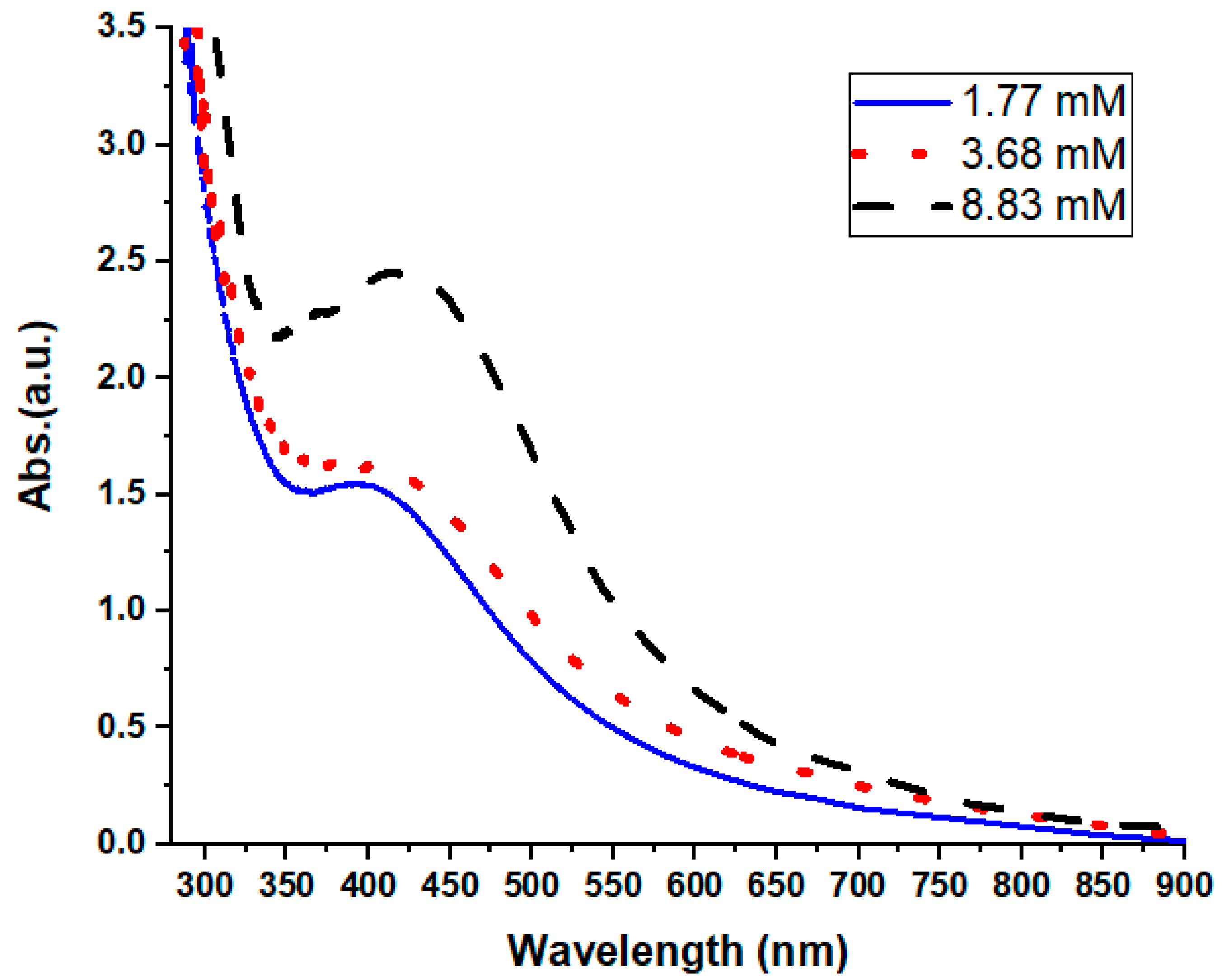
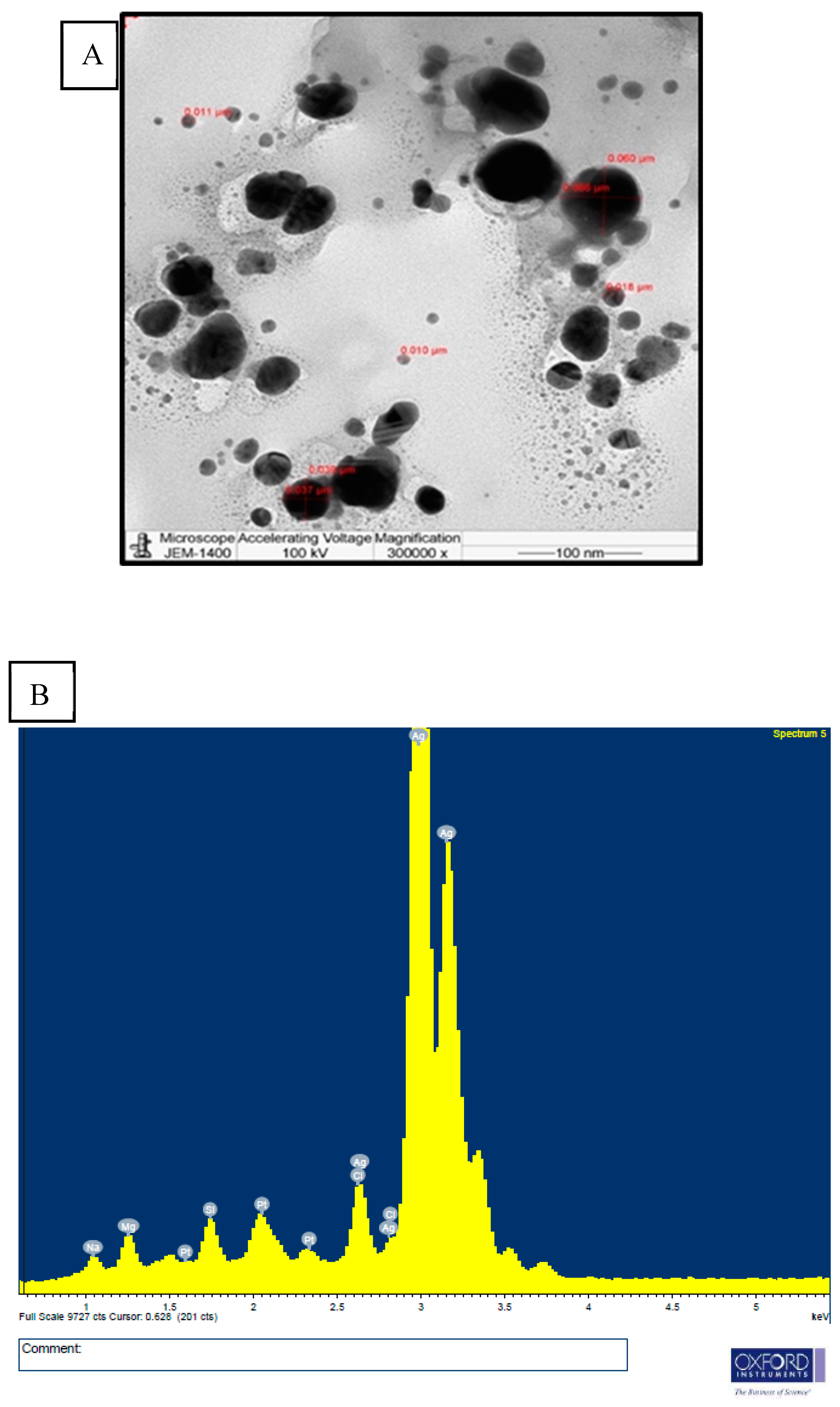
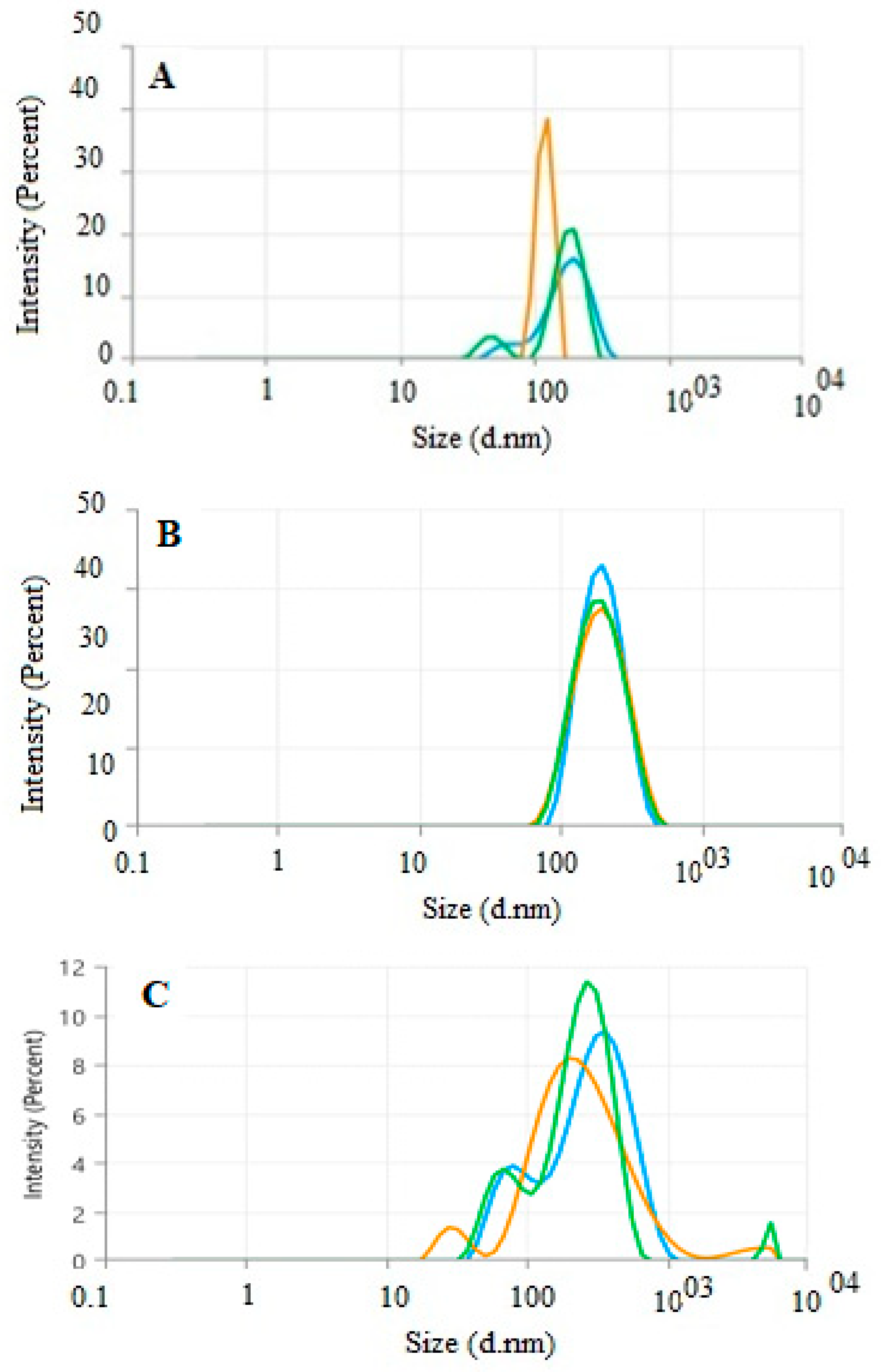


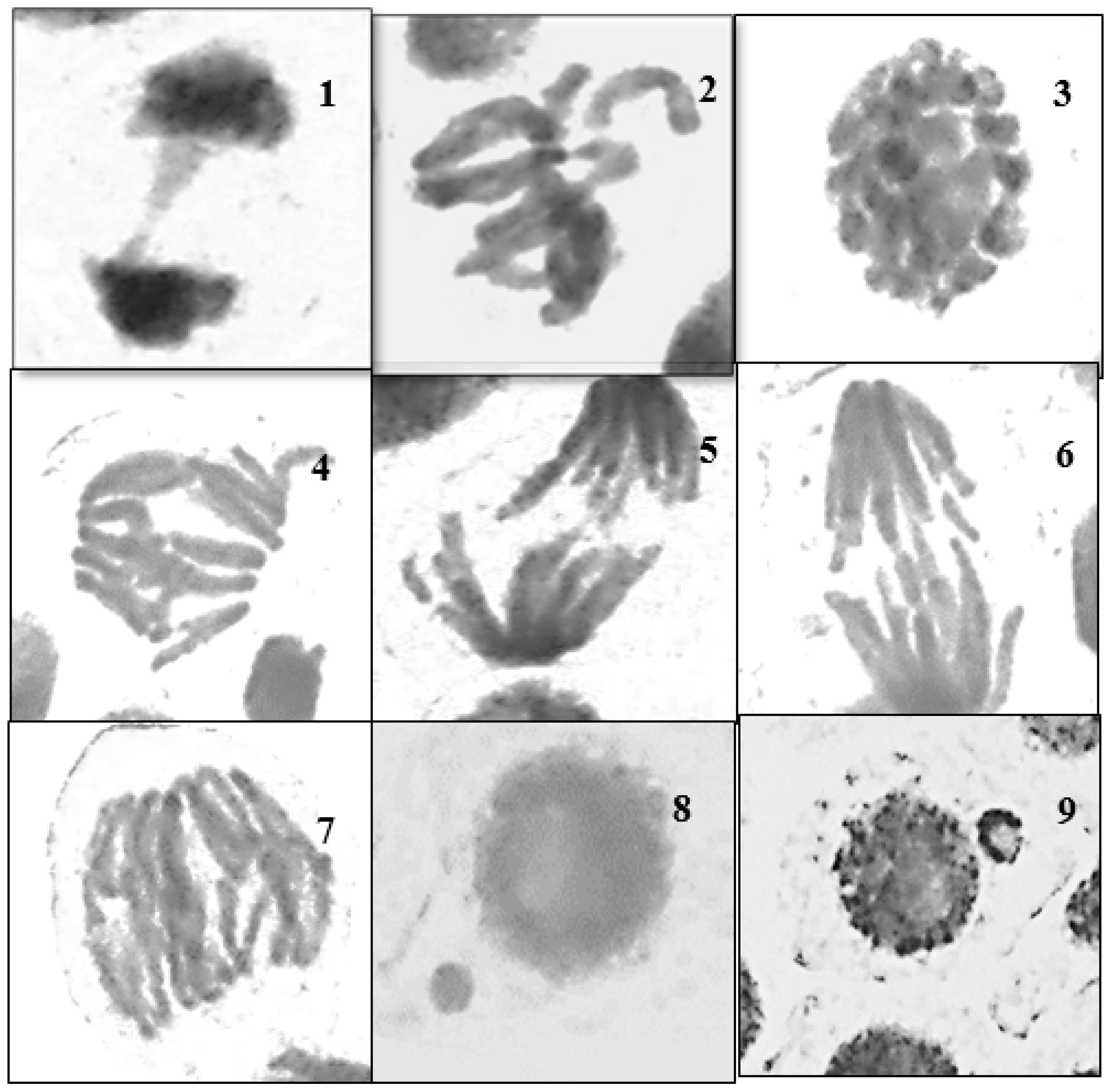

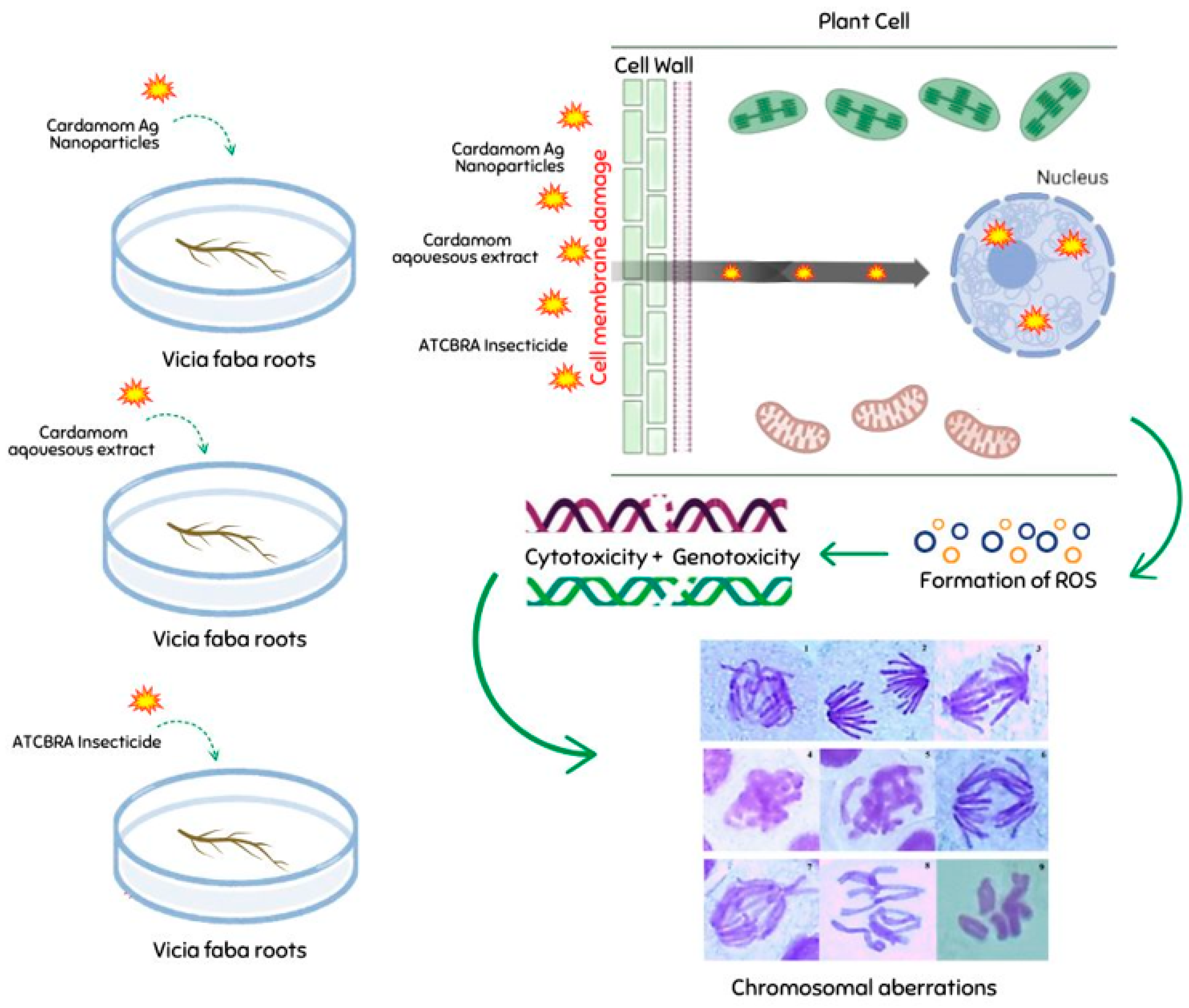
| Treatments | Exposure Time (h) | Concentration | Mitotic Index MI ± SE |
|---|---|---|---|
| ATCBRA insecticide | 24 h | Control | 18.7 ± 4.3 |
| 0.1% | 24.2 ± 3.5 | ||
| 0.3% | 15.7 ± 2.6 | ||
| 0.5% | 10 ± 0.8 | ||
| 0.7% | 5.9 ± 0.9 * | ||
| Elettaria cardamomum extract | Control | 18.7 ± 4.3 | |
| 3% | 20.5 ± 2.4 | ||
| 4% | 21.8 ± 1 | ||
| 5% | 20.7 ± 1.3 | ||
| 6% | 15.4 ± 1.3 | ||
| Cardamom–AgNPs | Control | 18.7 ± 4.3 | |
| 12 mg/mL | 10.4 ± 1.5 | ||
| 25 mg/mL | 4.8 ± 0.9 * | ||
| 60 mg/mL | 5 ± 0.8 * | ||
| ATCBRA insecticide | 48 h | Control | 6.7 ± 1 |
| 0.1% | 3.8 ± 1.4 | ||
| 0.3% | 4.7 ± 0.1 | ||
| 0.5% | 3.1 ± 0.4 * | ||
| 0.7% | 3.6 ± 0.1 * | ||
| Elettaria cardamomum extract | Control | 6.7 ± 1 | |
| 3% | 4.5 ± 0.7 | ||
| 4% | 4 ± 1.4 | ||
| 5% | 6.1 ± 0.5 | ||
| 6% | 5.7 ± 0.3 | ||
| Cardamom–AgNPs | Control | 6.7 ± 1 | |
| 12 mg/mL | 4.7 ± 1.4 | ||
| 25 mg/mL | 3.3 ± 0.8 | ||
| 60 mg/mL | 6.7 ± 0.8 |
| Treatments | Exposure Time (h) | Concentration | Chromosomal Aberration % CA ± SE |
|---|---|---|---|
| ATCBRA insecticide | 24 h | Control | 9.1 ± 2.4 |
| 0.1% | 12.9 ± 4.6 | ||
| 0.3% | 16 ± 1.2 * | ||
| 0.5% | 42.9 ± 2.9 * | ||
| 0.7% | 14.3 ± 2.3 | ||
| Elettaria cardamomum extract | Control | 9.1 ± 2.4 | |
| 3% | 17.8 ± 4.7 | ||
| 4% | 9.5 ± 1.6 | ||
| 5% | 9.9 ± 2.4 | ||
| 6% | 15.9 ± 4.2 | ||
| Cardamom–AgNPs | Control | 9.1 ± 2.4 | |
| 12 mg/mL | 27.7 ± 11.4 | ||
| 25 mg/mL | 30.4 ± 3.6 * | ||
| 60 mg/mL | 19.7 ± 2.5 * | ||
| ATCBRA insecticide | 48 h | Control | 16.8 ± 3.6 |
| 0.1% | 16 ± 4.1 | ||
| 0.3% | 30.3 ± 3.1 * | ||
| 0.5% | 48.5 ± 12.3 * | ||
| 0.7% | 22.6 ± 9.3 | ||
| Elettaria cardamomum extract | Control | 16.8 ± 3.6 | |
| 3% | 35.5 ± 6 * | ||
| 4% | 31.1 ± 7.9 * | ||
| 5% | 20.6 ± 0.6 * | ||
| 6% | 10.7 ± 1.7 | ||
| Cardamom–AgNPs | Control | 16.8 ± 3.6 | |
| 12 mg/mL | 38.5 ± 7.3 | ||
| 25 mg/mL | 37.7 ± 2.8 | ||
| 60 mg/mL | 39.5 ± 2.1 * |
Disclaimer/Publisher’s Note: The statements, opinions and data contained in all publications are solely those of the individual author(s) and contributor(s) and not of MDPI and/or the editor(s). MDPI and/or the editor(s) disclaim responsibility for any injury to people or property resulting from any ideas, methods, instructions or products referred to in the content. |
© 2025 by the authors. Licensee MDPI, Basel, Switzerland. This article is an open access article distributed under the terms and conditions of the Creative Commons Attribution (CC BY) license (https://creativecommons.org/licenses/by/4.0/).
Share and Cite
Al-Saleh, M.A.; Al-Harbi, H.F.; Al-Humaid, L.A.; Awad, M.A. An Assessment of the Cyto-Genotoxicity Effects of Green-Synthesized Silver Nanoparticles and ATCBRA Insecticide on the Root System of Vicia faba. Nanomaterials 2025, 15, 77. https://doi.org/10.3390/nano15010077
Al-Saleh MA, Al-Harbi HF, Al-Humaid LA, Awad MA. An Assessment of the Cyto-Genotoxicity Effects of Green-Synthesized Silver Nanoparticles and ATCBRA Insecticide on the Root System of Vicia faba. Nanomaterials. 2025; 15(1):77. https://doi.org/10.3390/nano15010077
Chicago/Turabian StyleAl-Saleh, May A., Hanan F. Al-Harbi, L. A. Al-Humaid, and Manal A. Awad. 2025. "An Assessment of the Cyto-Genotoxicity Effects of Green-Synthesized Silver Nanoparticles and ATCBRA Insecticide on the Root System of Vicia faba" Nanomaterials 15, no. 1: 77. https://doi.org/10.3390/nano15010077
APA StyleAl-Saleh, M. A., Al-Harbi, H. F., Al-Humaid, L. A., & Awad, M. A. (2025). An Assessment of the Cyto-Genotoxicity Effects of Green-Synthesized Silver Nanoparticles and ATCBRA Insecticide on the Root System of Vicia faba. Nanomaterials, 15(1), 77. https://doi.org/10.3390/nano15010077






